Isoform-specific ras activation and oncogene dependence during MYC- and Wnt-induced mammary tumorigenesis
- PMID: 16908535
- PMCID: PMC1636749
- DOI: 10.1128/MCB.00404-06
Isoform-specific ras activation and oncogene dependence during MYC- and Wnt-induced mammary tumorigenesis
Abstract
We have previously shown that c-MYC-induced mammary tumorigenesis in mice proceeds via a preferred secondary pathway involving spontaneous activating mutations in Kras2 (C. M. D'Cruz, E. J. Gunther, R. B. Boxer, J. L. Hartman, L. Sintasath, S. E. Moody, J. D. Cox, S. I. Ha, G. K. Belka, A. Golant, R. D. Cardiff, and L. A. Chodosh, Nat. Med. 7:235-239, 2001). In contrast, we now demonstrate that Wnt1-induced mammary tumorigenesis proceeds via a pathway that preferentially activates Hras1. In addition, we find that expression of oncogenic forms of Kras2 and Hras1 from their endogenous promoters has markedly different consequences for the progression of tumors to oncogene independence. Spontaneous activating Kras2 mutations occurring in either MYC- or Wnt1-induced tumors were strongly associated with oncogene-independent tumor growth following MYC or Wnt1 downregulation. In contrast, Hras1-mutant Wnt1-induced tumors consistently remained oncogene dependent. Additionally, Kras2-mutant tumors exhibited substantially higher levels of ras-GTP, phospho-Erk1/2, and phospho-Mek1/2 compared to Hras1-mutant tumors, suggesting the involvement of the ras/mitogen-activated protein kinase (MAPK) pathway in the acquisition of oncogene independence. Consistent with this, by use of carcinogen-induced ras mutations as well as knock-in mice harboring a latent activated Kras2 allele, we demonstrate that Kras2 activation strongly synergizes with both c-MYC and Wnt1 in mammary tumorigenesis and promotes the progression of tumors to oncogene independence. Together, our findings support a model for tumorigenesis in which c-MYC and Wnt1 select for the outgrowth of cells harboring mutations in specific ras isoforms and that these secondary mutations, in turn, determine the extent of ras/MAPK pathway activation and the potential for oncogene-independent growth.
Figures

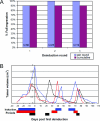
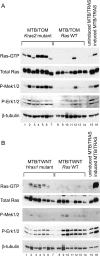
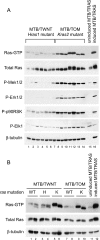
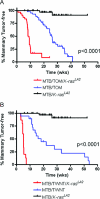
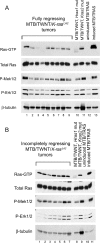
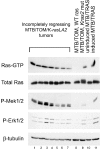
Similar articles
-
c-MYC induces mammary tumorigenesis by means of a preferred pathway involving spontaneous Kras2 mutations.Nat Med. 2001 Feb;7(2):235-9. doi: 10.1038/84691. Nat Med. 2001. PMID: 11175856
-
Dose-dependent oncogene-induced senescence in vivo and its evasion during mammary tumorigenesis.Nat Cell Biol. 2007 May;9(5):493-505. doi: 10.1038/ncb1567. Epub 2007 Apr 22. Nat Cell Biol. 2007. PMID: 17450133
-
Signal transduction pathways activated and required for mammary carcinogenesis in response to specific oncogenes.Oncogene. 1998 Feb 12;16(6):737-46. doi: 10.1038/sj.onc.1201829. Oncogene. 1998. PMID: 9488037
-
c-Myc and activated Ras during skin tumorigenesis: cooperation at the cancer stem cell level?Ernst Schering Found Symp Proc. 2006;(5):13-26. doi: 10.1007/2789_2007_042. Ernst Schering Found Symp Proc. 2006. PMID: 17939293 Review.
-
Drugging "undruggable" genes for cancer treatment: Are we making progress?Int J Cancer. 2021 Jan 1;148(1):8-17. doi: 10.1002/ijc.33197. Epub 2020 Aug 7. Int J Cancer. 2021. PMID: 32638380 Review.
Cited by
-
Lactate detection in inducible and orthotopic Her2/neu mammary gland tumours in mouse models.NMR Biomed. 2013 Jan;26(1):35-42. doi: 10.1002/nbm.2816. Epub 2012 Jul 5. NMR Biomed. 2013. PMID: 22767445 Free PMC article.
-
MicroRNA-335-5p and -3p synergize to inhibit estrogen receptor alpha expression and promote tamoxifen resistance.FEBS Lett. 2017 Jan;591(2):382-392. doi: 10.1002/1873-3468.12538. Epub 2017 Jan 12. FEBS Lett. 2017. PMID: 28008602 Free PMC article.
-
Pubertal and adult windows of susceptibility to a high animal fat diet in Trp53-null mammary tumorigenesis.Oncotarget. 2016 Dec 13;7(50):83409-83423. doi: 10.18632/oncotarget.13112. Oncotarget. 2016. PMID: 27825136 Free PMC article.
-
Genetic mechanisms in Apc-mediated mammary tumorigenesis.PLoS Genet. 2009 Feb;5(2):e1000367. doi: 10.1371/journal.pgen.1000367. Epub 2009 Feb 6. PLoS Genet. 2009. PMID: 19197353 Free PMC article.
-
β-Catenin and K-RAS synergize to form primitive renal epithelial tumors with features of epithelial Wilms' tumors.Am J Pathol. 2011 Dec;179(6):3045-55. doi: 10.1016/j.ajpath.2011.08.006. Epub 2011 Oct 8. Am J Pathol. 2011. PMID: 21983638 Free PMC article.
References
-
- Berger, M. S., G. W. Locher, S. Saurer, W. J. Gullick, M. D. Waterfield, B. Groner, and N. E. Hynes. 1988. Correlation of c-erbB-2 gene amplification and protein expression in human breast carcinoma with nodal status and nuclear grading. Cancer Res. 48:1238-1243. - PubMed
-
- Boxer, R. B., J. W. Jang, L. Sintasath, and L. A. Chodosh. 2004. Lack of sustained regression of c-MYC-induced mammary adenocarcinomas following brief or prolonged MYC inactivation. Cancer Cell 6:577-586. - PubMed
Publication types
MeSH terms
Substances
Grants and funding
LinkOut - more resources
Full Text Sources
Other Literature Sources
Molecular Biology Databases
Research Materials
Miscellaneous
